Health & Medicine
&nsbp;
Gorean Medicine
Introduction
Medicine on Gor is not heavily discussed, however, based on the following excerpt, it would seem that at least in the cities, the practice of medicine was advanced, though how advanced, it is not ever truly defined. Please note the words "relatively advanced." More than likely, the medical technology of Gor would rival that of ancient Rome, as depicted on the main Medical page, based upon certain implements mentioned briefly within the books themselves.
"There is at least one area, however," said my father, "in which the Priest-Kings do take a most active interest in this world, and that is the area of technology. They limit, selectively, the technology available to us, the Men Below the Mountains. For example, incredibly enough, weapon technology is controlled to the point where the most powerful devices of war are the crossbow and lance. Further, there is no mechanized transportation or communication equipment or detection devices such as the radar and sonar equipment so much in evidence in the military establishments of your world.
"On the other hand," he said, "you will learn that in lighting, shelter, agricultural techniques, and medicine, for example, the Mortals, or Men Below the Mountains, are relatively advanced." — Tarnsman of Gor, page 31
All too often seen in virtual chat Gor, are healers that bring contemporary Earth healing methods into role play. Well-baby care, prenatal care, MRIs, and such are all 21st century earth culture, and not Gorean. Too, depending upon the culture involved, medical practice is likely to be quite simplistic. For example, the Wagon Peoples hold a great distrust for things of the city as well as the written word. The red savages were distrustful of anything to do with the white man. It's quite unreasonable to expect a full-fledge hospital burning bright energy bulbs with bustling nurses and tubes and tubes of IVs and nuclear machines blinking off and on in the jungles or the plains of Turia or the Tahari. Not that you'd even see something akin to that in the cities!
But I have seen nuclear medicine used in chatrooms. Considering that the Priest-Kings were considered with anything that could lead to potential weapon risks, nuclear technology would never be allowed, even in medicine.
To see such practices in a roleplay room is rather an indulgence by those portraying such; perhaps because they wish not to take the time to learn a more simplistic medical practice. Of course, most roleplayers portraying a healer or physician — is not either in real life, and instead practice a Marcus Welby, MD sort of medical practice in roleplay rooms. It's obnoxiously annoying, especially for those who truly want realism in roleplay.
Too, we see a lot of healing remedies that are of earth nature (i.e., willow-bark, dandelion, agrimony, etc.) which are doubtful would be found on Gor. What we can probably determine is the variety of curatives available based on specific vegetation found on Gor.
More often than not, I see someone do something with regards to medicine on Gor, or create medical manuals, that have no backing in the books. But wait. There are excuses. Reasons, sorry. There are reasons why there is willow-bark on Gor; and agrimony. And nuclear medicine. And well-baby books. The reasoning that I've seen given often is — "When I went to Earth on a Voyage of Acquisition, I brought back what I needed." Or, "I visited with a merchant who had been a part of a Voyage of Acquisition and he brought back things necessary." Or, "I brought the items with me when I was captured on Earth." And the list goes on …
Mind you, out of the mouths often of those who cry out for more "realism" in roleplaying. In fact, here is an actual verbatim post that was made October 2005 in a room in Alter Realm, provided to me by a friend (names have been removed for obvious reasons):
(19:47:19 )
[PIC]
name deleted
title deleted
near the Warmth of the Fire
says toname deleted: and I just returned from urth so I am well stocked on supplies
WHOA!!! — Now… what is wrong with these statements?! Plenty is wrong!
First off, who in hell is that person, a mere human, to override what careful balance that the Priest-Kings established on the planet? People seem to forget that it was the Priest-Kings that brought people to the world of Gor, with already certain technology afforded to humans. No doubt they also brought much of the flora and fauna upon the planet's surface, from which medications often are derived. For a mere human to decide that the Priest-Kings are wrong, is a mighty lofty opinion of one's self.
Secondly — humans did NOT go on Voyages of Acquisition. Those were the ventures of the Priest-Kings. It seems people confuse the agents of the Kur, which often were humans, and their raids upon the planet of Earth to be Voyages of Acquisitions. They were not. They were slave raids one-hundred percent. Only with a sinister purpose, which was to infiltrate slaves amongs key persons on Gor in an effort for the Kurii to take over not only Gor, but Earth as well.
Thirdly, we have to remember that yes, there are Earth-born living on Gor, these were generally all slaves, save for a very rare few, and any earth-born who are brought to Gor would never be allowed in the physician's caste, or any clan structure. These people, firstly, are not allowed to claim a homestone; barbarians they are called and barbarians are even lower than a Gorean-born slave girl.
Fourthly, we see a lot of healing remedies that are of earth nature (i.e., willow-bark, dandelion, etc.) which are doubtful would be found on Gor. Remember, all living things brought to Gor evolved into varieties of beast and plant far different than their Earth (or other planetary) origins.
What we can probably determine is the variety of curatives available based on specific vegetation found on Gor. In my pages, I'll be exploring those plants that are found on Gor, which can be used medicinally and most likely were. I have done extensive research on medicine and medical practices on Gor, including birth control, menstruation (yes, folks, menstruation is a fact of life on Gor as well), sip root and slave wine (which inhibits fertility and not menstruation), and herbs and remedies that would be found on Gor, versus those that are not supported as being practical (i.e., willow-bark and agrimony).
The Practice of Physicians
Physicians practice in the cities and their primary duties tend to be more toward ensuring everyone, Free and slave, receives their stabilization serum injections and the examination of slave girls. The following passage may help enlighten on more of medicine found in the cities of Gor:
"The building where I would wait on these days was the house of a physician. I was taken through a corridor to a special, rough room, where slaves were treated. There my camisk would be removed. On the first day the physician, a quiet man in the green garments of his caste, examined me, thoroughly. The instruments he used, the tests he performed, the samples he required were not unlike those of Earth. Of special interest to me was the fact that this room, primitive though it might be, was lit by what, in Gorean, is called an energy bulb, and invention of the Builders. I could see neither cords nor battery cases. Yet the room was filled with a soft, gentle, white light, which the physician could regulate by rotating the base of the bulb. Further, certain pieces of his instrumentation were clearly far from primitive. For example, there was a small machine with gauges and dials. In this he would place slides, containing drops of blood and urine, flecks of tissue, a strand of hair. With a stylus he would note readings on the machine, and, on the small screen at the top of the machine. I saw, vastly enlarged, what reminded me of an image witnessed under a microscope. He would briefly study this image, and then make further jottings with his stylus. The guard had strictly forbidden me to speak to the physician, other than to answer his questions, which I was to do promptly and accurately, regardless of their nature. Though the physician was not unkind I felt that he treated me as, and regarded me as, an animal. When I was not being examined, he would dismiss me to the side of the room, where I would kneel, alone, on the boards, until summoned again. They discussed me as though I were not there." — Captive of Gor, page 92.
However, there are highly skilled physicians who often perform studies, usually by experimentation utilizing slaves, especially to gain knowledge of why some are prone to Dar-Kosis, or the "Holy Disease." Although the Priest-Kings are very technologically advanced, including medicine, they do not allow humans to become too advanced. For that to happen, would mean the end of Gor, much like how humans have destroyed Earth.
Although surgeries themselves were never spoken of in the books, experiments were administered by the physicians of the cities, as well as, the Priest-Kings. A general anesthetic was commonly used by physicians of the cities, known as capture scent, most likely chloroform. In other uses, such as by slavers, the liquid poured into a cloth, then the cloth placed over the person's mouth and nose, until he or she is rendered unconscious or administered by darts. Bandaging and sterile supplies were also mentioned only vaguely within the books. In the Schendi region, bandages are made of simple leaves bound tightly around a wound.
I attempted to conceal one vial, which we had not permitted her to sample. But her eye was too quick for me. "What is that ?" she asked, sharply.
"It is nothing," I said.
"Let me smell it," she said.
"Please, no, great lady!" I begged.
"You thought to keep it from me, did you ?" she laughed.
"Oh, no, great lady," I wept.
"Give it to me," she said.
"Must I, lady?" asked I.
"I see," said she, "beating is not enough for you. It seems you must be boiled in the oil of tharlarion as well!" I lifted it to her, piteously. She laughed. My assistant and I knelt before her, at her feet. She wore, beneath her green velvet, golden shoes. "Uncork it for me, you sleen," said she. I wondered if I had, in my life, seen ever so scornful, so proud, so cold a woman. I uncorked the vial. "Hold it beneath my nostrils," she said. She bent forward. I held the vial beneath her delicate nostrils. She closed her eyes, and breathed in, deeply, expectantly. She opened her eyes, and shook her head. "What is this ?" she said.
"Capture scent," I said.
I held her forearms. Ivar Forkbeard quickly pulled the bracelets and rings from her wrists and fingers. He then threw from her neck the golden chains. I pulled her to her feet, holding her wrists. Ivar tore the golden string from her hair, loosening it. It fell behind her, blond, below the small of her back. He tore the collar of her gown back from her throat, opening it at her neck. — Marauders of Gor, page 115.
"Shall I hold again the vial beneath her nose?" I asked. Soaked in a rag and scarf and held over the nose and mouth of a female it can render her unconscious in five Ihn. She squirms wildly for an Ihn or two, and then sluggishly, and then falls limp. It is sometimes used by tarnsmen; it is often used by slavers. Anesthetic darts, too, are sometimes used in the taking of females; these may be flung, or entered into her body by hand; they take effect in about forty Ihn; she awakens often stripped, in a slave kennel. — Marauders of Gor, page 116.
Medicine in Ancient Rome
As I stated previously, the ancient Romans were quite advanced in their medical practices, especially with regards to surgery. The ancient Greeks laid the foundation of contemporary medicine; the ancient Romans expanded on it. Early Romans had a religious, yet fundamental understanding of medicine. Deriving knowledge from the Medical Treatises and Methods of the Greeks, the Etruscans, the Egyptians, the Persians and other conquered peoples, the Romans came up with one of the best and most sophisticated Medical Systems of the Ancient World. The science of medicine and the human body was evolving. Ancient Roman medicine was a combination of physical techniques using various tools and holistic medicine using rituals and religious belief systems.
The practice of reading livers was common in the Roman world. (Gosh, I'm getting a shiver of familiarity in this, are you?) After an animal was sacrificed its liver was examined by a priest who would interpret the liver. Looking at the liver, the priest would reveal good or bad omens from it. It was thought that the gods responses were communicated through the liver and other internal organs of a sacrificed animal. Healing was sought after from religious temples. Sacrifices were made to gods in particular Asklepios in hopes of receiving healing.
Hospitals were originally built for the military. Under Gaius Marius, the Roman Army became the world's best trained and disciplined force, and some of this rubbed off onto the Medics too. The influence of superstitious quakery lessened and Roman Medicine took on a more practical approach. It was still a trial and error process, but the Medics were more observant and carefully noted down any treatment that worked and this knowledge was passed on and could be successfully utilized by the next doctor.
The fifteen-year civil war that directly following the assassination of Julius Caesar led to significant medical innovations. The war was fought between the best armies of the world and yielded such high levels of injury that the newly emerged emperor, Augustus, formed a professional military medical corps. Before this, doctors had fairly low status. August, realizing that they were key in an empire and especially an army, gave all physicians that joined his new army medical corps dignified titles, land grants, and special retirement benefits!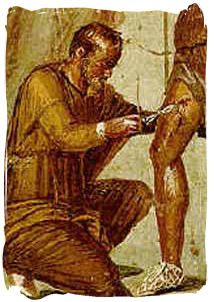 For the next five hundred years, fueled by the motivations and opportunity for medical advancement supplied by the many battles, and supported by the powers that be, this serious group advanced the study and practice of medicine to a level not seen again until late in the nineteenth century. The first Roman Medical Corps was formed by Emperor Augustus, and as he gave land grants, dignified titles, and special retirement gifts to the doctors, the profession lost its shoddy aspect and became respectable. It helped too that Medical professionals hereafter were required to train at the new Army Medical School and could not practise unless they passed. This increased the success rates in treatments.
For the next five hundred years, fueled by the motivations and opportunity for medical advancement supplied by the many battles, and supported by the powers that be, this serious group advanced the study and practice of medicine to a level not seen again until late in the nineteenth century. The first Roman Medical Corps was formed by Emperor Augustus, and as he gave land grants, dignified titles, and special retirement gifts to the doctors, the profession lost its shoddy aspect and became respectable. It helped too that Medical professionals hereafter were required to train at the new Army Medical School and could not practise unless they passed. This increased the success rates in treatments.
Ancient Roman medicine was, surprisingly, incredibly similar to that of the late nineteenth century. Like the modern medical practice, Ancient Roman medicine was split among different specialties, such as internists, ophthalmologists, and urologists. All surgical tasks were only preformed by appropriate specialists. Surgeons used practically the same tools as American doctors did only one hundred years ago. An Ancient Roman doctor's tool kit would include forceps, scalpels, catheters, and even arrow-extractors. Similarly, Ancient Roman surgeons had a wide range of painkillers and sedatives to help in surgery, including extracts of opium poppies (morphine) and of henbane seeds (scopolamine). There is little doubt that the many folk remedies used throughout the Roman Empire were tested in battle by Roman physicians on wounded and ailing soldiers, who sifted through and found the treatments and methods with the most useful effects. Further, the bureaucracy of Rome ensured that the treatments were recorded and taught in the medical school.
The Romans did not yet really understand how germs related to disease, but they did use many of the techniques that killed germs, techniques that were not reinvented until much later. For example, they boiled their tools before use and would not reuse the same tool on a patient before reboiling. Wounds were washed with acetum, which is actually a better antiseptic than Joseph Lister's carbolic acid (Joseph Lister rediscovered antiseptics in the 1860's, based on Louis Pasteurıs brand-new germ theory of disease).
In Ancient Rome, it was common knowledge that arteries and veins carried blood. All surgeons knew how to use tourniquets, arterial clamps, and ligatures to stem blood flow. They also used amputation to prevent deadly gangrene.Over the years, Roman war doctors also learned how to prevent many battlefield epidemics. They accomplished this by placing forts away from insect infested swamps. They also installed drains and sewers to transport sewage away from the men. Similarly, they invented sophisticated permanent hospitals, with specialized rooms for different tasks, and with isolation of some patients from others to reduce the spread of disease. Central heating and good ventilation also helped patients.
Wartime doctors of the Roman army created most of the innovations because they were organized, they were distributed throughout the Empire, they were careful about capturing and spreading any new inforamtion or technique that worked, and they were highly motivated by the great loss of life suffered by their soldiers during the many battles.
Archaeological sites have produced many implements used in ancient Roman surgery — some dating to 460 BC. This is the timeline Hippocrates wrote The Oath — a pledge still taken today by doctors to perform to their fullest ability.
Roman Medics studied Medical texts by Hippocrates, who came from the Greek Island of Cos and is generally regarded as the Father of Medicine. Actually, he was only one of a longstanding line of medical practitioners, but his personal popularity ensured that his treatises were saved by his followers while those written by his predecessors, which nobody saved, were lost to the coming ages. Besides the writings of Hippocrates, other writers wrote on medical topics. There were Medical Practitioners whose writings were equally revered:
- Aretaeus of Cappadocia was a Greek physician of the 1st century. He wrote a treatise on diseases, their causes, symptoms, and cures, which is still extant.
- Galen (130-200 AD) described many of the medical instruments used by both Roman and Greek doctors. Under Emperor Augustus, he compiled informative Medical texts and manuals. Galen was perhaps the most well-known of the Roman Medics, who left detailed writing about physiology and surgical processes, including the various medical and surgical intruments then in use.
- Pedanios Dioscorides (65 A.D.), who wrote a text on Herbal Medicine that was referred to for the next 1500 years and is still in use today in Alternative Medicine.
- Soranus of Ephesus, who wrote on Obstetrics and Gynecology.
- Onbasius wrote an encyclopedia of medicine which was in a collection of 70 books around 325 AD.
Recently, a military hospital at Baden has produced a large collection of medical tools. A stone mural of Roman legion depicts a fellow solider helping another remove probably an arrow from his leg with a pair of pinchers. Some soldiers were skilled in medical while still serving in the army. The negative realm of Roman medicine started in its early history.
Some of the various instruments used in surgical practices I will provide here on display, along with summaries of the known uses of each instrument. The extant comments of medical writers from antiquity — including Oribasius, Galen, Soranus, Aetius, and the Hippocratic corpus — have provided scholars with some clues about the use of some instruments. Some instruments, such as mixing instruments and tweezers, probably had other household such as the application of cosmetics and paints. These instruments were excavated from the House of the Surgeon at Pompeii, so named because of the materials that were recovered there. The collection is one of the best surviving examples of the tools at a surgeon's disposal in the first century BCE. Since there was relatively little innovation in surgery and surgical tools from the time of Hippocrates (5th century BCE) and Galen (2nd century CE) this collection is typical of surgical practice for nearly a millenium. In fact, the technology of some tools, such as the vaginal speculum, did not change significantly until the 20th century.
Medical and Surgical Instruments of Ancient Rome and Greece
Following is a list with pictures of various instruments used in ancient Greece and Rome, as well as the Latin or Greek term for the instrument.
• Bone Forceps
Shown here: Greek and Roman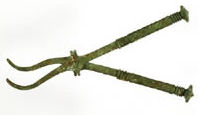 In Greek: ostagra
In Greek: ostagra
Soranus (lxiv) says that in case of impaction of the foetal cranium, the head may be opened with a sharp instrument and the pieces of the skull removed with bone forceps. Paul Aigenita (VI.xc) says that in a depressed fracture of the skull "fractured bone is to be removed in fragments, with the fingers if possible, if not, with a bone forceps."
• Bone Drills
Shown here: Roman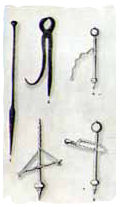
Bone drills, looking like wine cork screws were used to remove diseased bone tissue from the skull and extract sizable foreign objects such as a weapon from a bone. Bone forceps were used to extract small pieces of bone that would be otherwise difficult to remove with fingers.
• Bone Hooks
Shown here: Roman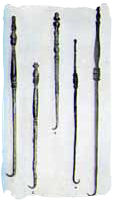
Bone hooks, long thin metal instruments were used as probes and the maneuvering small pieces of tissue more easily. Hooks were another common instrument used regularly by Greek and Roman doctors. The hooks the ancient doctors used came in two basic varieties: sharp and blunt. Both of these types of hooks are still used by modern surgeons' for many of the same purposes for which the ancient doctors first used them. For instance, blunt hooks were primarily used as probes for dissection and for raising blood vessels. Sharp hooks, like those pictured in the accompanying image, were used to hold and lift small pieces of tissue so that they could be extracted and to retract the edges of wounds. Refer also to Obstretic / Sharp Hooks
• Bone Levers
Shown here: Roman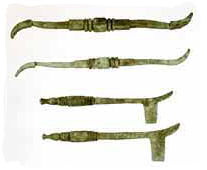
In Greek: mochliskos
From what Galen says, these instruments were used for levering fractured bones into position and may have been used for levering out teeth. I can so appreciate my dentist.
• Clyster For Administering Enemas
Shown here: Greek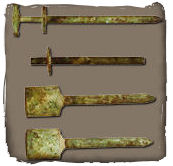 In Greek: metregchutes
In Greek: metregchutes
Painful looking, isn't it? Bend over and say, "ahhhhhhh…" *shudders*
• Cupping Vessels For Bloodletting
Shown here: Roman and Greek
In Greek: sikua
In Latin: cucurbitulae
The larger cupping vesssel would have been used for larger areas on the body, such as the back or thighs. The smaller vessel would have been applied to the arms.
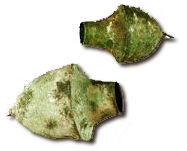 |
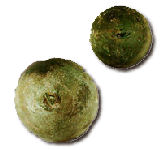 |
• Epilation Forceps
Shown here: Roman and Greek In Greek: tricholabis
In Greek: tricholabis
In Latin: vulsella
By far the largest number of forceps of this type are not surgical instruments, but household implements. Many were used for epilation (hair removal) or by artists.
• Male Catheter
Shown here: Roman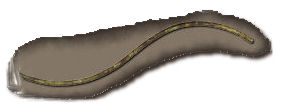
Catheters, long metal tubes, like those we have today were used to help open up a blocked urinary tract infections. Inserted in the male urethra for the evacuation of urine.
• Obstetrical Hooks / Sharp Hooks
Shown here: Roman and Greek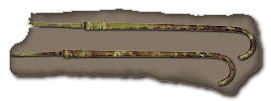 In Greek: agkistron
In Greek: agkistron
In Latin: hamus, acutus
Hooks, blunt and sharp, are frequently mentioned in both Greek and Latin literature, and served the same possible purposes we use them for: the blunt for dissecting and raising blood-vessels like the modern aneurism needle; the sharp for seizing and raising small pieces of tissue for excision and for fixing and retracting the edges of wounds. In dissection, many of the manipulations which we perform with the dissecting forceps were performed by the ancients with sharp hooks. Refer also to Bone Hooks.
• Portable Probe Case
Shown here: Roman and Greek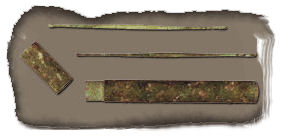 In Greek: kauterion
In Greek: kauterion
In Latin: ferrum candens
This plain cylindrical case was used to store and protect the thin probes and curettes used by physicians. Hippocrates mentions a portable equipment case for use on housecalls.
• Probes and Curettes
Shown here: Roman and Greek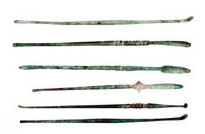 In Greek and Latin: cyathiscomele
In Greek and Latin: cyathiscomele
The scope of the cyathiscomele in medical art is evidently, like the flat spathomele, to act occasionally as a sound, but mainly to mix, measure and apply medicaments. Some are adapted for use as curettes. The large numbers in which this instrument occurs would itself indicate that it was used for lay as well as medical purposes.
• Rectal Speculum
Shown here: Greek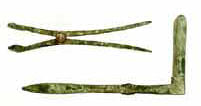
In Greek: hedrodiastoleus
The earliest mention of the rectal speculum is to be found in the treatise on fistula by Hippocrates (iii.331): "… laying the patient on his back and examining the ulcerated part of the bowel by means of the rectal speculum…"
All I can say is … ouch.
• Scalpels
Shown here: Roman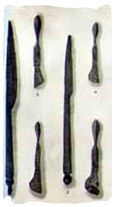 Scalpels, made of steel or bronze were used to make incisions. Scalpels could be made of either steel, bronze, or a combination of the two metals — such as a steel blade and a bronze handle. Ancient scalpels had almost the same form and function as their modern counterparts do today. The two long steel scalpels that make up the first and third columns of the accompanying image are examples of the most ordinary type of scalpel from antiquity.
Scalpels, made of steel or bronze were used to make incisions. Scalpels could be made of either steel, bronze, or a combination of the two metals — such as a steel blade and a bronze handle. Ancient scalpels had almost the same form and function as their modern counterparts do today. The two long steel scalpels that make up the first and third columns of the accompanying image are examples of the most ordinary type of scalpel from antiquity. 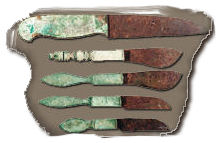 These long scalpels could be used to make a variety of incisions, but they seem to be particularly suited to making either deep or long cuts. The four bronze scalpels which make up columns two and four are generally referred to as "bellied scalpels." This variety of scalpel was another favorite of physicians in antiquity since the shape of its handle allowed more delicate and precise cuts to be made.
These long scalpels could be used to make a variety of incisions, but they seem to be particularly suited to making either deep or long cuts. The four bronze scalpels which make up columns two and four are generally referred to as "bellied scalpels." This variety of scalpel was another favorite of physicians in antiquity since the shape of its handle allowed more delicate and precise cuts to be made.
• Surgical Scissors
Shown here: Greek and Roman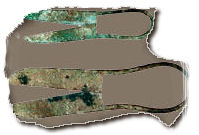 In Greek: psalis
In Greek: psalis
In Latin: forfex
The surgical author Oribasius treats the cutting of hair as a regular medical procedure in a special chapter of his work. Celsus also frequently refers to cutting the hair as a therapeutic measure. Possibly the ancients found difficulty in putting an edge sufficiently smooth for surgical purposes on their shears. We have few references to the use of the shears for cutting tissues.
• Spatula Probes
Shown here: Greek and Roman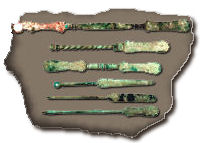 In Greek and Latin: spathumele
In Greek and Latin: spathumele
Almost every medical writer mentions the spathomele. It consists of a long shaft with an olivary point at one end and a spatula at the other. It was a pharmaceutical rather than a strictly surgical instruement. The olive end was used for stirring medicaments, the spatula for spreading them on the affected part. The spathomele was used by painters for preparing and mixing their colors. The very large numbers in which they are found would indicate that their use was not confined to medical men.
• Tile Cautery
Shown here: Roman and Greek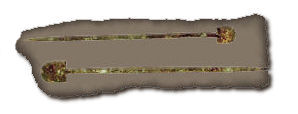 In Greek: kauterion
In Greek: kauterion
In Latin: ferrum candens
The cautery was employed to an almost incredible extent in ancient times, and surgeons expended much ingenuity in devising different forms of this instrument. The cautery was employed for almost every possible purpose: as a 'counter-irritant', as a haemostatic, as a bloodless knife, as a means of destroying tumors, etc.
• Tubes to Prevent Contractions and Adhesion
Shown here: Roman and Greek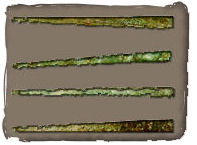 In Greek: motos molubous
In Greek: motos molubous
In Latin: plumbea fistula
After operations on the nose, rectum, vagina, etc., it was usual to insert a tube of lead or bronze to prevent contraction or adhesion and also to convey medicaments.
• Uvula Forceps
Shown here: Greek In Greek: staphylagra
In Greek: staphylagra
In Aetius (II.iv.2), there is an interesting description of the amputation of the uvula by first crushing it in a forceps so as to prevent haemorrhage and then cutting it off. Hippocrates (I.63) mentions the uvula crusher as one of the instruments necessary for the outfit of the physician.
• Vaginal Speculum
Shown here: Roman and Greek: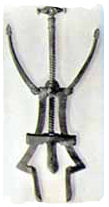 In Greek: dioptra
In Greek: dioptra
In Latin: speculum magnum matricis
One of the most spectacular, if fearsome looking, Roman medical instruments is the vaginal dilator or speculum (dioptra). It comprises a priapiscus with 2 (or sometimes 3 or 4) dovetailing valves which are opened and closed by a handle with a screw mechanism, an arrangement that was still to be found in the specula of 18th-century Europe. Soranus is the first author who makes mention of the speculum specially made for the vagina. Graeco-Roman writers on gynecology and obstetrics frequently recommend its use in the diagnosis and treatment of vaginal and uterine disorders, yet it is one of the rarest surviving medical instruments. Specula are large and readily recognizable and should not have suffered the same degree of destruction as thin instruments, such as probes, scalpels and needles. As a source of bronze, however, they may have been more subject to recycling than the smaller instruments.
Birth Control on Gor
Birth control was widely used, especially among female slaves. Free women too, perhaps not wishing to bear children so soon to her Companion, would obtain — often unscrupulously — birth control means.
• Sip Root and Slave Wine, Contraceptives and Menstruation
A bitter root whose extract is the active ingredient in slavewine; it is used as a form of contraceptive for slave girls of the red savages. Slave wine, a by-product of the bitter sip root, was developed by the caste of physicians, and later perfected per requirements set forth by slavers and masters. It is not, however, something that is administered by such physicians. Slave wine is a ceremonial thing, given to a slave by her master. In the event that a slave is a part of a large slave house or a city or camp slave, the slave wine then is administered by the whip master. Slave wine is indefinite in its effects, although because of the ceremonial effect between a master and his slave, often he will renew such relationship by annually having her receive the slave wine. Although slave wine is a high-need item, the availability of such, tends to greatly reduce the cost of the mixture and is widely carried through-out gorean markets. The sip root in itself is effective, but the lasting effects are not indefinite, and therefore the slaves must ingest the root every three to four months.
Sip root (and the derivative drink, slave wine) is the only contraceptive found on Gor. Being that slave wine was created by the caste of physicians gives us every reason to believe that there would be nothing else on Gor that can be used as a contraceptive. Contrary to what I have seen in chat rooms, sip root and slave wine do not inhibit menstruation, but only render the woman infertile for a given time, such as the birth control of earth. In fact, menstruation is mentioned in the books, though neither in great detail nor in excess.
• Free Women and Contraceptives
There was no mention of free women using contraceptives. Most likely the reason being, is that while the slave girl's purpose is not to breed, it is the basis for Free Companionship, the procreation of children to carry on the family names and traditions. Therefore, we can safely assume that free women did not partake of contraceptives for if they became pregnant, they would then be fulfilling the contractural part of the free companionship. There was an instance when a free woman has been given slave wine, such as being placed for use as a form of punishment, or in the case of TIffany (Kajira of Gor) who wished to experience what it is to be a slave, was given the drink as a safeguard. It's been conjectured that free women get a "sweeter" version of this contraceptive drink, based upon this latter reference because Tiffany had commented on why she was not being provided it sweetened. Though she was acting as a slave, she wished to be treated according to her station, Tatrix and free woman, and thus felt she should not drink the concoction in which a slave would drink, thus the sweetener to denote that though it was slave wine, it was hidden with sugar so that she did not feel so much a slave.
"The two females," I told him, "have recently been free. Accordingly, as soon as they have been collared, force them to drink slave wine." Slave wine is bitter, intentionally so. Its effect lasts for more than a Gorean month. I did not wish the females to conceive. A female slave is taken off slave wine only when it is her master's intention to breed her. — Marauders of Gor, pages 23-24.
"Holding the blanket about me, I went to him. He proffered me a cup and I, with one hand, holding the blanket about me with the other, drank its contents. It was a foul brew, but I downed it. I did not know at the time, but it was slave wine. Men seldom breed upon their slave girls. Female slaves, when bred, are commonly hooded and crossed with a male slave, similarly hooded, the breeding conducted under the supervision of their respective owners; a girl is seldom bred with a slave from her own house; personal relationships between male and female slaves are usually frowned upon; sometimes, however, as a discipline even a high female slave is sometimes thrown to a chain of work slaves for their pleasure. The effect of the slave wine endures several cycles, or moons; it may be counteracted by another drink, a smooth, sweet beverage, which frees the girl's body for the act of the male slave, or, in unusual cases, should she be freed, to the act of the lover; slave girls, incidentally, are almost never freed on Gor; they are too delicious and desirable to free; only a fool, it is commonly said, would free one." — Slave Girl of Gor, page 70.
What is it?" I asked, startled. It seemed he had produced this almost by magic. It was a soft, leather botalike flask drawn from within his tunic.
"Slave wine," he said.
"Need I drink that?" I asked, apprehensively.
"Unless you have had slave wine," he said, "I have no intention of taking you through the streets clad as you are. Suppose you are raped."
I put the flask, which he had opened, to my lips. Its opening was large enough to drink freely from. "It is bitter!" I said, touching my lips to it.
"It is the standard concentration, and dosage," he said, "plus a little more, for assurance. Its effect is indefinite, but it is normally renewed annually, primarily for symbolic purposes. I could not believe how bitter it was. I had learned from Susan, whom I had once questioned on the matter, the object. It is prepared from a derivative of sip root. The formula, too, I had learned, at the insistence of masters and slavers, had been improved by the caste of physicians within the last few years. It was now, for most practical purposes, universally effective. Too, as Drusus Rencius had mentioned, its effects, at least for most practical purposes, lasted indefinitely. … — Kajira of Gor, pages 130-131.
"Could it not be sweetened?" I asked.
"I have chosen that you drink it as it is," he said, "as it is normally drunk."
"You would have the Tatrix of Corcyrus drink unsweetened slave wine?" I asked.
"Shall we return to the palace?" he asked.
"I will drink it," I said. I was a bit irritated with Drusus Rencius. Clad as I was before him, he had seemed to become much more domineering, much more aggressive with me, than he had before. Something in me resented this, but I felt something else, something deeper within me, how deep I did not know, excited and deeply moved, responding to it.
"Do you wish help in drinking it?" he asked.
"How could you help me drink it?" I asked, puzzled.
" The female is put on her knees," he said. "The man crouches behind her. Her head and body are bent back. Her nostrils are pinched shut. The liquid is then poured into her mouth. Before she can breathe, she must swallow. In this way even a frightened or stubborn girl, early in her bondage, learns that she must, if her master wishes it, accept nourishment."
"What if she keeps her mouth closed, her teeth clenched?" I asked. "What if she chooses to expel the nourishment later?"
"A mouth may be forced open," he said. "Too, it is difficult to induce gagging if the hands are tied behind one." … — Kajira of Gor, pages 131.
"Why did you make me drink unsweetened slave wine?" I asked.
He looked me over, casually, not hurrying, from my head to my toes, and then, slowly, back. "It was fitting," he said. — Kajira of Gor, pages 132."We make them chew carefully and watch closely to see that they swallow, bit by bit, in small swallows, sip roots, as well," said another.
"We then examine their mouths, forcing them widely open, to determine that they have finished their entire allotment of the root," said another. I nodded. Sip roots are extremely bitter. Slave wine, incidentally, is made from sip roots. The slaves of the red savages, like slaves generally on Gor, would be crossed and bred only as, and precisely as, their masters might choose. — Blood Brothers of Gor, pages 124-125.I held the object before her. She regarded it with dismay. "I have already chewed sip root within the moon," she said.
"Open your mouth," I said.
"Yes, Master," she said. I then thrust the object into her mouth.
"Chew it well," I said, "and swallow it, bit by bit." She grimaced, at the barest taste of the object. "Begin," I told her. She began. "Not so quickly," I told her. "More slowly. Very slowly. Very, very slowly. Savor it well." She whimpered in obedience. She did not need the sip root, of course, for, as she had pointed out, she had had some within the moon, and, indeed, the effect of sip root, in the raw state, in most women, is three or four moons. In the concentrated state, as in slave wine, developed by the caste of physicians, the effect is almost indefinite, usually requiring a releaser for its remission, usually administered to a slave, in what is called the breeding wine, or the "second wine." When this is administered she usually knows that she has been selected for crossing with a handsome male slave.
Such breedings commonly take place with the slaves hooded, and under the supervision of the master, or masters. In this way the occurrence of the breeding act can be confirmed and authenticated. Sometimes a member of the caste of scribes is also present, to provide certification on behalf of the city. Usually, however, in cities which encourage this sort of registration it is sufficient to bring the papers for stamping to the proper office within forty Ahn. Such rigor, however, is usually involved only in the breeding of expensive, pedigreed slaves. Most slave breeding is at the discretion of the private master or masters involved. Slaves from the same household, incidentally, are seldom mated. This practice is intended to reduce the likelihood of intimate emotional relationships among slaves. Furthermore, male and female slaves are usually kept separate, female slaves commonly performing light labors in households and male slaves working in the fields or on the grounds. Sometimes, to reward male slaves, or keep them content, or even to keep them from going insane, a female slave is thrown to them. This is sometimes a girl of delicate sensibilities from the house who has not been perfectly pleasing; she then finds herself thrown naked to work slaves. In slave matings, since most crossings do not take place within the same household, a stud fee is usually paid to the master of the male slave. The active ingredient in the breeding wine, or the "second wine," is a derivative of teslki. In the matter of bitterness of taste there is little to choose from between raw sip root and slave wine, the emulsive qualities of the slave wine being offset to some extent by the strength of the concentrations involved. — Blood Brothers of Gor, pages 319-320."How long, after all, she placed there without slave wine, at the exactly ideal moment in her breeding cycle, does it take to impregnate a slave?" — Renegades of Gor, page 200.
"Have you had your slave wine?" asked Ina.
" Yes," I said. This is not really a wine, or an alcoholic beverage. It is called "slave wine," I think, for the amusement of the masters. It is extremely bitter. One draught of the substance is reputed to last until the administration of an appropriate "releaser." In spite of this belief, however, or perhaps in deference to tradition, lingering from earlier times, in which, it seems, less reliable "Slave wines" were available, doses of this foul stuff are usually administered to female slaves at regular intervals, usually once or twice a year. Some girls, rather cynical ones, I suspect, speculate that the masters give it to them more often than necessary just because they enjoy watching them down the terrible stuff. This is unlikely, however. There are cheaper and more easily available ingredients for such a mode of discipline than slave wine.
"Good," said Ina. "There is then nothing to worry about." I looked at her. It had not occurred to me, really, that I had "nothing to worry about." "The time to worry," said Ina, "is if they decide to make you a breeding slave." I nodded. "You must then drink the releaser," she said. I nodded numbly. "I have been told it is quite good," she said. I looked at her, with horror. "Really," she said.
Slave wine makes sense in a slave-holding culture, such as Gor. The breeding of slaves, like any sort of domestic animals, and particularly valuable ones, is carefully controlled. As a slave, of course, I could be bred, or crossed, when, and however, my master might see fit. It is the same as with other animals. — Dancer of Gor, pages 174-175.
Scientific Experimentation and Lab Animals
Interesting in the following quote is the evidence of the use of laboratory rats, or in the case of Gor, urts, as well as other animals unnamed, for scientific experimentation on the development of medicines.
"You seem to me, from what I have seen and heard," I said, "a skilled Physician."
"In the fourth and fifth year of the reign of Marlenus," said he, regarding me evenly, "I was first in my caste in Ar." — Assassin of Gor, page 265.
I took a swallow. "Then," said I, "you discovered paga?"
"No," said he.
"A girl?" I asked.
"No," said Flaminius, smiling. "No." He took another swallow. "I thought to find," said he, "an immunization against Dar-kosis."
"Dar-Kosis is incurable," I said.
"At one time," said he, "centuries ago, men of my caste claimed age was incurable. Others did not accept this and continued to work. The result was the Stabilization Serums." — Assassin of Gor, pages 265-266.
Dar-Kosis, or the Holy Disease, or Sacred Affliction, is a virulent, wasting disease of Gor. Those afflicted with it, commonly spoken of simply as the Afflicted Ones, may not enter into normal society. They wander the countryside in shroudlike yellow rags, beating a wooden clapping device to warn men from their path; some of them volunteer to be placed in Dar-kosis pits, several of which lay within the vicinity of Ar, where they are fed and given drink, and are, of course, isolated; the disease is extremely contagious. Those who contract the disease are regarded by law as dead.
"Dar-kosis," I said, "is thought to be holy to the Priest-Kings, and those afflicted with it to be consecrated to Priest-Kings."
"A teaching of Initiates," said Flaminius bitterly. "There is nothing holy about disease, about pain, about death." He took another drink.
"Dar-kosis," I said, "is regarded as an instrument of Priest-Kings, used to smite those who displease them."
"Another myth of Initiates," said Flaminius, unpleasantly. "But how do you know that?" I queried.
"I do not care," said Flaminius, "if it is true or not. I am a Physician."
"What happened?" I asked.
"For many years," said Flaminius, "and this was even before 10,110, the year of Pa-Kur and his horde, I and others worked secretly in the Cylinder of Physicians. We devoted our time, those Ahn in the day in which we could work, to study, research, test and experiment. Unfortunately, for spite and for gold, word of our work was brought to the High Initiate, by a minor Physician discharged from our staff for incompetence. The Cylinder of Initiates demanded that the High Council of the Caste of Physicians put an end to our work, not only that it be discontinued but that our results to that date be destroyed. The Physicians, I am pleased to say, stood with us. There is little love lost between Physicians and Initiates, even as is the case between Scribes and Initiates. The Cylinder of the High Initiate then petitioned the High Council of the City to stop our work, but they, on the recommendation of Marlenus, who was then Ubar, permitted our work to continue." Flaminius laughed. "I remember Marlenus speaking to the High Initiate. Marlenus told him that either the Priest-Kings approved of our work or they did not; that if they approved, it should continue; if they did not approve, they themselves, as the Masters of Gor, would be quite powerful enough to put an end to it." — Assassin of Gor, pages 266-267.
"What happened then?" I asked.
Flaminius took another drink, and then he looked at me, bitterly. "Before the next passage hand," said he, "armed men broke into the Cylinder of Physicians; the floors we worked on were burned; the Cylinder itself was seriously damaged; our work, our records, the animals we used were all destroyed; several of my staff were slain, others driven away." He drew his tunic over his head. I saw that half of his body was scarred. "These I had from the flames," said he, "as I tried to rescue our work. But I was beaten away and our scrolls destroyed." He slipped the tunic back over his head. … — Assassin of Gor, page 267.
"I had," he said, "shortly before the fire developed a strain of urts resistant to the Dar-kosis organism; a serum cultured from their blood was injected in other animals, which subsequently we were unable to infect. It was tentative, only a beginning, but I had hoped I had hoped very much."
"The men who attacked the Cylinder," I said, "who were they?"
"Doubtless henchmen of Initiates," said Flaminius. Initiates, incidentally, are not permitted by their caste codes to bear arms; nor are they permitted to injure or kill; accordingly, they hire men for these purposes.
"Were the men not seized?" I asked.
"Most escaped," said Flaminius. "Two were seized. These following the laws of the city, were taken for their first questioning to the courts of the High Initiate." Flaminius smiled bitterly. "But they escaped," he said. — Assassin of Gor, pages 267-268.
"Did you try to begin your work again?" I asked.
"Everything was gone," said Flaminius, "the records, our equipment, the animals; several of my staff had been slain; those who survived, in large part, did not wish to continue the work." He threw down another bolt of Paga. "Besides, said he, "the men of Initiates, did we begin again, would only need bring torches and steel once more."
"So what did you do?" I asked.
Flaminius laughed. "I thought how foolish was Flaminius," he said. "I returned one night to the floors on which we had worked. I stood there, amidst the ruined equipment, the burned walls. And I laughed. I realized then that I could not combat the Initiates. They would in the end conquer."
"I do not think so," I said.
"Superstition," said he, "proclaimed as truth, will always conquer truth, ridiculed as superstition." … — Assassin of Gor, page 268.
"One thing more to this little story," said Flaminius. lifted the bottle to me.
"What is that?" I asked.
"At the games on the second of En'Kara, in the of Blades," said he, "I saw the High Initiate, Complicius Serenus."
"So?" said I.
"He does not know it," said Flaminius, "nor will he learn for perhaps a year."
"Learn what?" I asked.
Flaminius laughed and poured himself another drink. "That he is dying of Dar-kosis," he said. — Assassin of Gor, pages 268-269.
Slaves and Healing
There has been some controversy on virtual Gor regarding slave girls performing healing duties. Not only was it mentioned about professional slaves, such as those who can perform professional duties (i.e., scribe, law), but the following quote supports the fact that slaves do tend to wounds as well; at least bandaging.
"I looked to the left and right over the torn, bloody barricade of wagons, at the remains of my men, wounded and exhausted, many of them lying on the barricade or on the ground behind it, trying to gain but a moment's respite. Free women, and even some Turian slave girls, went to and fro, bringing water and, here and there, where there was point in it, binding wounds." — Nomads of Gor, page 263.
![]()
Special Note
Because of the differences in publishing the books, depending upon whether published in the U.S. or Europe, depending upon whether a first publishing or a Masquerade Books release, page numbers will often vary. All of my quotes are from original, first-printing U.S. publications (see The Books page for a listing of publishers and dates) with the exception of the following books:
- Tarnsman of Gor (2nd Printing, Balantine)
- Outlaw of Gor (11th Printing, Balantine)
- Priest-Kings of Gor (2nd Printing, Balantine)
- Assassin of Gor (10th Printing, Balantine)
- Raiders of Gor (15th Printing, Balantine)
- Captive of Gor (3rd Printing, Balantine)
Disclaimer
These pages are not written for any specific home, but rather as informational pages for those not able to get ahold of the books and read them yourself. Opinions and commentaries are strictly my own personal views, therefore, if you don't like what you are reading — then don't. The information in these pages is realistic to what is found within the books. Many sites have added information, assuming the existences of certain products and practices, such as willowbark and agrimony for healing, and travel to earth and back for the collection of goods. I've explored the books, the flora, the fauna, and the beasts, and have compiled from those mentioned, the probabilities of certain practices, and what vegetation mentioned in the books is suitable for healing purposes, as well as given practicalities to other sorts of roleplaying assumptions.